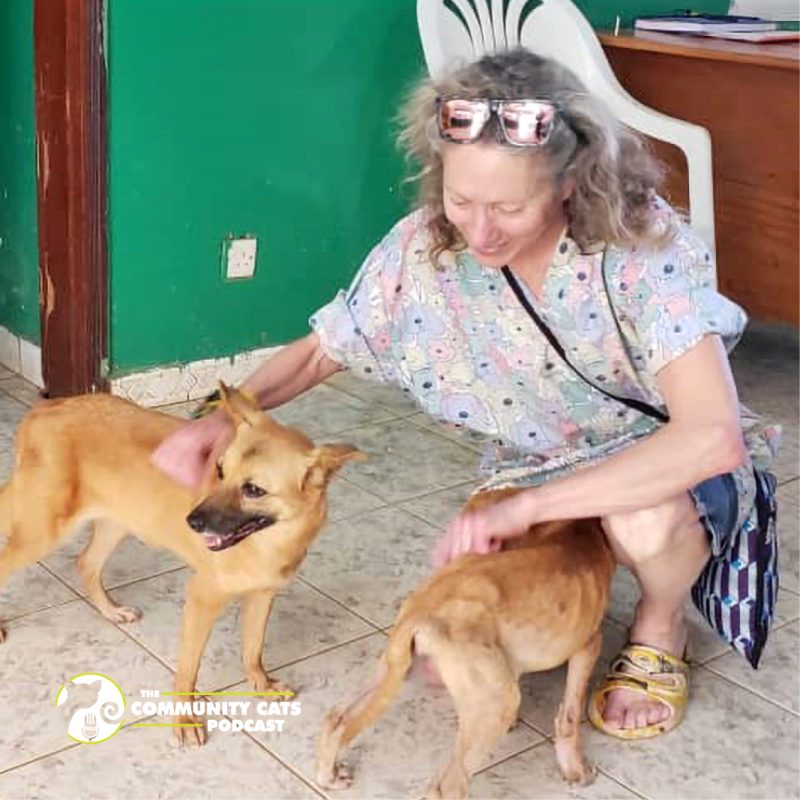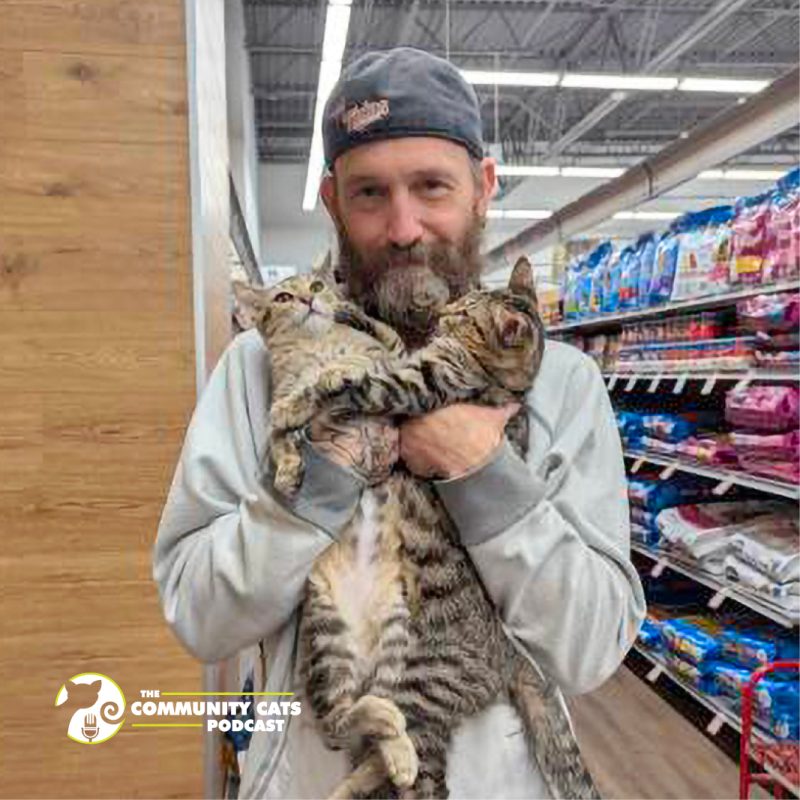
Center for Contemporary Sciences:Working Toward an Alternative to Animal Testing
February 18, 2021
How to Get Girl Scouts More Involved with Animal Shelters—Whether You’re a Scout, a Troop Leader, or a Shelter
February 25, 2021
“Anybody that’s had cats recognizes that they’re highly intelligent and absolutely capable of learning.”
Listen to Episode #392 Now
This episode is sponsored in part by Tamadori and Doobert.com.
Steve Appelbaum has more than 40 years of dog training and pet industry experience. He is the creator of Animal Behavior College (ABC) which provides many different pet industry certifications. ABC started off with only programs for dog training but Steve noticed a big problem with cats being surrendered or euthanized for treatable behavioral problems, so he set out to fix this problem.
Steve and Stacy debunk the myth that cats can’t be trained and discuss how training cats isn’t about teaching obedience like it is for dogs, but actually treating behavioral problems. Steve gives some tips on how to train your cat for going to the vet and shares how enrichment and training go hand in hand. We in the animal welfare community know there is a shortage of veterinary assistants and veterinarians; Stacy and Steve talk about how ABC’s veterinary assistant program is their most popular program and they expect to have 2200 students enrolled in the next year.
You can find Stacy’s niece and her adventure cat on Instagram @lily.lebaron. To find out more about Animal Behavior College or to register for a course, visit their website or call 800-795-3294.
Read Episode #392 Now
Kristen Petrie [00:00:02]
You've tuned in to the Community Cats Podcast. Ready? Let's go.
Stacy LeBaron [00:00:12]
Welcome to the Community Cats Podcast. I am your host, Stacy LeBaron. I've been involved helping homeless cats for over twenty years with the Merrimack River Feline Rescue Society. The goal of this podcast is to expose you to amazing people who are improving the lives of cats. I hope these interviews will help you learn how you can turn your passion for cats into action. Today, we're speaking with Steve Applebaum. With forty years of dog training and pet industry experience, Steve Applebaum used his extensive knowledge and business acumen to create Animal Behavior College, the largest specialty school of its kind in North America. ABC offers pet industry certification courses in all fifty states and every Canadian province, and the ABC alumni group boasts the largest number of certified dog trainers in the United States. ABC combines a home study curriculum with hands-on externship training. Initially the school only offered a dog trainer program. However, Applebaum also observed a critical, and at the time untreated issue, regarding cats in the United States. A staggering eight hundred and sixty thousand cats are euthanized each year, many for untreated and often solvable and/or preventable behavioral challenges. There was and is still a perception that cats can't be trained. As a professional animal trainer, Applebaum knew this was wrong and dedicated himself and his school to becoming part of a viable solution, to reducing the numbers of cats abandoned and rehomed due to behavioral challenges, by educating the public that cats are highly trainable. To accomplish this, ABC created a cat trainer program dedicated to teaching people to become professional cat trainers. Today, ABC offers five core programs in dog training, cat training, pet grooming, veterinary assisting, aquatics management and zookeeper assisting. ABC has graduated and certified more than twenty-four thousand three hundred students in the United States and Canada combined. Welcome, Steve, to the show.
Steven Applebaum [00:02:09]
Well, thank you. It's a pleasure to be here.
Stacy [00:02:12]
So, before we take a deep dive in all that information about training cats and everything, how did you become passionate about cats?
Steven [00:02:18]
Well, I've always loved kitties but I became passionate about cat training as a dog trainer. What I found was this, twenty maybe thirty percent of my clients, dog training clients, had cats and they had questions about very normal and I would later find treatable behavioral challenges. And so I would get these questions, you know, well, thanks for help with the dog but my cat is scratching up the couch. What can I do? Or the cat doesn't want to use a litter box. What can I do? Or how can I get the cat and the dog to get along together? And, you know, at first I was stymied because that wasn't my experience, wasn't my skill set, but I got these questions often enough. This is, this goes back, this is the eighties that I started asking other trainers hey, are you getting these questions? And many of them were. And so, then the obvious next question is, well, what can we do about it? Are, you know, these problems solvable? Am I crazy to think this? And some of the trainers of the time said, well, yes, you are crazy to think this, cats can't be trained, but that didn't make sense. I mean, anybody that's had cats recognizes that they're highly intelligent and absolutely capable of learning. I mean, you watch them every day they can learn new things. And so it's really just a matter of not whether they were trainable but how you would go about training. Clearly they weren't going to respond the same way dogs would and you would look to train them for different things. And so that's, that started me on my journey. And at the time there was really not a lot of information out there. Some of this was trial and error. Some of it was connecting with trainers that had been looking at these questions and delving for answers for a few years longer than I had been. And over a period of about ten or fifteen years, we came up with what we thought were viable solutions to common behavioral challenges and found that many people were receptive to the idea of not only the cats were trainable but the viable solutions that we could give to them. So it was really just an evolutionary process for me, but I loved it. And I found that a lot of the dog trainers that I connected with love the idea as well because dog trainers are animal lovers and many of them had cats and love cats. And they were thrilled at the idea that wow, they could help kitties just way they could help dogs and the people that love them. So it started from there and then it sort of evolved over time.
Stacy [00:04:46]
It's really funny. I've had my own sort of experience with regards to cat training recently. I have been born and raised a cat lover and I sort of have always appreciated sort of the independent spirit of cats and they're not trainable and that kind of thing. And my niece recently adopted a kitty, Lily, and she's Lily.LeBaron on Instagram, if you want to check her out because she's, so my niece has always been a dog person. So she had lots of dogs in her life and several of them were like therapy dogs and she'd gone to school to train them to be therapy dogs and that kind of thing. And so when she got this kitten, she just obviously felt oh, well, I can do the same things that I did in a certain way with the kitten that she could do with the dogs. So she's, you know, doing clicker training and the cat goes in the backpack and travels around and goes out on the kayak and actually swims in the lake with them and that kind of thing. And I mean, has her own little life preserver and it's really amazing. But, you know, it was this mindset of like, when I was visiting my brother's house they were like, oh, we're all going to go outside and I'm like, okay, we're going to leave the cat in the house and they're like, no, she's coming with us. And I was like, wow, you know, that's not the attitude that I would have but through the training that she's done with her, they're able to have her continue to be part of that family grouping, you know, outside of the house. And I would assume, do you think that helps with the behavior of the cat in the house?
Steven [00:06:19]
Sometimes. Absolutely can, I mean if you have the ability to get the cat out and you can take kitty on a variety of, you know, safe outings, get the cat more exercise. There's definitely a correlation between exercise and boredom behavior. So, not to mention the fact that it's just going to assist in the bond between the pet parent and kitty. So yes, a hundred percent that will help. Not, it's not directly related to all behavioral challenges. I mean litterbox challenges might have nothing to do with that but the more you can involve yourself and bring the cat into your life, if you will, the better off you're going to be. And I would love, are these pictures on Instagram? I will definitely check it out. I want to see kitty swimming.
Stacy [00:07:02]
Yeah, it's Lily.LeBaron is her Instagram handle. Sort of a technical question but it's one that intrigues me. What is the difference between, you know, enrichment versus training?
Steven [00:07:16]
I mean, I guess it depends on how you use the terms. I mean proper training can involve enrichment. So, for example, if you have a cat that is, and you see this a lot with kitty parents, you know, they'll have a dog and they'll have fifteen toys, okay, but the cat won't have any toys at all, or very few. And they can't understand why when they leave for X number of hours a day, and that's a little less common now with COVID but people still go out and about and cats and dogs are left to their own devices. They don't have anything to keep them occupied. They get bored and they keep themselves occupied sometimes with the cushions on your couch or you know, with your curtains, your drapes whatever. So by enrichment, by giving a cat the opportunity to engage in interesting things in their environment when you're gone, you can help address boredom related behavior. And that's true, by the way, with both dogs and cats. You give them different things to do but it's the same basic principle. So, you know, I would argue that enrichment really should be a part of a training regime. You know, too often people, and I think this is part of where the disconnect occurs with cat training, is that people make an association. They hear the word training and because it's more commonly associated with dogs, they immediately go to dog on a leash learning obedience cues, you know, walking, heeling or loose leash walking, or sitting or staying and you can obviously teach cats to do that but a lot of people think to themselves, why would I bother? I don't really need that. Now to your point earlier. It's potentially a really helpful thing to be able to, have that cat that you can control in public because you can take the cat to more places safely, but for a lot of people the thought of doing that with a cat just doesn't resonate. And so the idea of training doesn’t resonate but in reality training isn't so much about teaching cues, obedience cues, as it is, at least the way we teach it in addressing common but very treatable behavioral challenges. And for most people when you say it well cats can't be trained, you know, they're not praise oriented, they're too independent or whatever. If you ask them a series of questions, like, okay, so if your cat can't be trained, what do you plan on doing with those litter boxes? I mean you're going to teach the cat to go to the litterbox, right? Well, yes. Well that's training. Just a matter of how you're going to do it. Okay. You've got a cat tree in the, a scratching post rather in the corner there. You want to train the cat to scratch on that and not your furniture right? Well, yes. That's training. It's just a matter of how you go about it and avoiding some common pitfalls that can get you into problems. So hopefully that answers the question. I would answer that enrichment and training are essentially two sides of the same coin and you have a different definition of it?
Stacy [00:10:14]
No, I tend to feel like the cat world falls on enrichment more heavily than training and feels like they've done enough for their cats just by providing them a few cat toys, or, you know, providing them with a scratching post. But I do think that there is a component of training in there that we don't acknowledge like training to the litter box. And in some cases, if you have an outdoor kitty, you know, training that cat to come home for wet food at night, or something like that, or getting them into the barn, the barn cats, and there's a way to train your outdoor cats to respond in certain ways so that you can help keep them safer at night. Maybe in that kind of thing. So, let's embark on the cat training program that you have at your school and what is that like? I mean, if somebody was interested in training their cat, what would you recommend?
Steven [00:11:04]
Well, if somebody is interested in training their personal cat, you don't necessarily need to come to take our program. Our program is for people that are interested in becoming cat trainers. Now you could certainly take our program if you wanted to learn how to train your own cat but, you know, at fifteen hundred dollars, you probably are going to be better off seeking the assistance of a cat trainer. Now, for people that are looking to make this either a part-time or a full-time career, or who want to learn these skills so that they can volunteer at a shelter or a rescue, then absolutely, you should look to take a program like ours. So, to those people that are interested in becoming cat trainers. Yes, you know, by all means do some research and you know, look at our school and see what we have to offer. For those people that are cat owners, cat parents, well, we certainly wouldn't turn you away if you wanted to take our program. We would be better off assisting you by pointing you in the direction of cat trainers, of which there are greater numbers now than ever before. And that's really our goal at Animal Behavior College. Two goals, one to create a little bit more awareness, actually a lot more awareness, in the general public that cats are trainable and two, to help create as many cat trainers, teach as many cat trainers as we possibly can. So that when people go looking, they can find trainers that are using humane effective methods, to assist them in, you know, having wonderful relationships with their cats. Our program is an eleven-stage course and it's taught sequentially. So it's a combination of distance learning coupled with a hands-on portion. So, for example, you wanted to take our program, you would get stages in sequence. So you wouldn't get to stage two until you graduated stage one, stage three after stage two, and so on and so forth until you got to stage nine, where we would place you at a rescue or shelter and you can, you can get some experience working there so that you can get some hands-on and you can see firsthand some of what you've learned about in the program. It’s very important to get a hands-on piece to this whole thing. And takes about twelve to fourteen, fifteen months to get through the course. It's fairly extensive but we think well worth it for people that really want to commit to making this a part of their lives, into making this a career.
Stacy [00:13:27]
So I'm going to ask you a question on the flip side of things. So if I'm part of a rescue or shelter group, and I don't necessarily have anybody specifically signed up for your program, is there a way to do a matchmaking with any of your students?
Steven [00:13:42]
Yes. Yes. We've got job boards for both dog trainers and cat trainers that we will encourage any shelter or rescue, you know, to please post on or to look on. We've got tons of both on these boards at our website at animalbehaviorcollege.com. So that if a shelter were looking to find a cat trainer, they could certainly connect with somebody most likely in their area. The coverage is not what we'd like it to be. That's going to take a little bit more time. I mean you were reading the stats
earlier about the dog trainers and we've got tens of thousands of dog trainers in all fifty states. You know, cat trainers, I believe right now we're at about, going to guess about three hundred fifty or so across the country. So it's a, this is a relatively new program. We've been doing this now for about five or six years and it's taken a little while. I mean, we've taken it slowly and it's really a matter of perception as more and more people realize that cats are trainable and this is a feasible way to make a living, more and more people get involved and they'll be more cat trainers out there.
– Start mid-roll advertising-
Stacy [00:14:54]
Your cat is your faithful companion. Always there to give you comfort and love when you need it most. So why not give them the same comfort and love with CBD oil designed just for cats? Tamadory Collection is a family-run business based out of greater Boston with a love and passion for cats. You can read more about their exciting new product Tamadory CBD Oil for Cats on their website at www.tamadorycollection.com. Tamadory CBD Oil for Cats is perfect for anxious cats who need relaxation support to promote calm, cats who suffer from health concerns to help boost immune health, older cats that have slowed down or suffer from joint discomfort who need to feel and move better and young cats to support the longest healthiest life. Ready to try Tamadory CBD Oil for Cats today? Enjoy ten dollars off your first bottle with code COMMUNITY CATS. So why wait? Try Tamadory Premium Cat CBD today for a happier healthier cat tomorrow and for years to come.
Stacy [00:15:52]
By now, you know how powerful the Doobert software platform is facilitating everything from transport to fostering with just a few clicks, but did you know that the team at Doobert also provides consulting and custom software development for your organization's needs? The team at Doobert has extensive experience in website design, SEO strategies, mobile application development and even advanced capabilities involving integration to social media and text messaging. Big or small, the team at Doobert can do it all. And because Doobert operates as a social enterprise, all of the revenue from their consulting services goes back into developing even more innovative and life-saving solutions for animal rescues around the world. So if you are planning to increase your digital presence online through a new website or some SEO strategies, or if your organization is looking for an experienced web development team to support your operations, look no further than the team at Doobert. Reach out to Chris today at Chris@doobert.com and he'd be glad to discuss what you're trying to accomplish and how they can help.
Stacy [00:16:55]
Community Cats Podcast is excited to announce a brand new event this year, the Online United Spay Alliance Conference. United Spay Alliance, or USA, is a non-profit nationwide source for affordable, accessible and timely spay/neuter services, education and policy. Together with USA, we will be bringing you amazing content on spay/neuter work starting on Friday, February twenty-sixth and running through Sunday, February twenty-eighth, twenty twenty-one. Conference topics include recruiting veterinarians and meeting rural needs, a COVID-19 panel, how to start a spay/neuter clinic including explanations of the various clinic models, transport models, how to make spay/neuter a priority in your community, grant making for spay/neuter, how to work with animal control and your board of health and many, many more. To see the full list of topics and speakers and to learn how you can register visit communitycatspodcast.com. We're excited about this new offering and we hope you will be too.
-End mid-roll advertising-
Stacy [00:18:01]
I want to take a little bit of time to focus in on one of your other core areas and that's the veterinary assistant program that you have because we have a veterinary assistant as well as veterinarian shortage out there. I would say, everybody in general is pretty clear to say, everybody is overworked, overwhelmed, overstressed. And you know, from participating in this program. Does it help the vet techs be able to sort of survive better?
Steven [00:18:30]
Yes, and it certainly does. I mean the vet techs will tell you that it's, to have decent veterinary assistants working with them makes their lives a whole lot easier. So, you know, our veterinary assistant program, and veterinary assistance is an interesting thing. That's our most popular program, we’ll probably wind up with about two thousand two-hundred students taking that course this year because a lot of people that are interested in this. Program works the same as the cat program in that it's an eleven-stage course, only, when we get to what we call the externship, we will place you in a veterinary hospital or clinic. We've got about three thousand of them that we work with across the country. Where, as a student, you will spend a minimum of a hundred hours there, just observing. You might be able to participate in some things, but it's mostly going to be an observational part for you. So that you can see and get a real feel for what this is like. And of course, hopefully build a relationship with the hospital that may, we don't guarantee that, of course, but may result in your being hired or at least being able to network to being hired once you graduate the program. There is by the way, a connection between the cat program and the veterinary assistant program in that, one of the things that we are teaching our veterinary assistant students is that it is absolutely possible and, actually I won’t say easy but it's definitely doable to teach cats to, if not love, certainly be okay with going into a carrier so that they can safely be transported to a veterinary hospital. In speaking with veterinary hospitals all over the country for years, we have heard that it's, this is a real challenge that they have with cat parents, where it's, they just don't get their cats to the vet with the same frequency as dog owners do. And the reason seems to be not because they don't love their cats but because they're impossible to get into the carriers to transport them. And so you typically only take kitty to the vet if it's a dire emergency and that's, that's not a good thing. So we're working with our veterinary assistant students, as well as of course, our cat training students so that they all come away from this program with an understanding about how you can teach cats to learn to tolerate their crates, which we really think will help, over time, in lessening the number of cats that wind up going to the veterinarian much too late because people just weren't taking them there for routine examinations. So, but all of our programs work the same way which is they’re distance learning combined with an externship, but we are finding that a quite a few veterinary assistant students are taking our cat training program. Although by far the greatest number of people that take our cat training program are dog trainers who are interested in simply expanding their ability to help more animals. They love dogs. They love cats. They're thrilled about the idea that they can help both and it increases their marketability as well. From just a business standpoint alone it makes eminent sense to make yourself more marketable. There are a lot of dog trainers out there. They're not nearly as many cat trainers. And so when you first start your business, especially if you're looking to network and go to veterinarians, your pet stores or various other places where you can hopefully gain their trust and gain referrals. When you walk in, you may be asked to stand on the end of a very long line because there have been a dozen trainers that walked in before you, but if you walk in with cat and dog training experience, you may be asked to stand on the end of a much shorter one which means you can build your business faster. So there are a whole host of reasons why it's really good to look at this program if you're, if you want to be in the animal industry.
Stacy [00:22:20]
So I just want to take a quick step back and ask you a question with regards to the getting the cat in the carrier, in a stress-free or less stressful situation. One recommendation I've heard over time is actually, you know, we shouldn't be tucking our carriers in the closet. That we should have them kind of out and about, and comfortable and encourage, you know, our kitties to go in and out, you know, is that part of that? Like, as a little tip for our listeners? Is that a good idea?
Steven [00:22:47]
Yes, that is absolutely part of it. The thing to understand is that the cat was not born with a negative association to the carrier. That is a learned association and then think about it. I mean if every time you went in a car or the vast majority of times you went in a car, you went to a place that you didn't like. Chances are that when you were brought anywhere near a car, you would resist getting into one. People would react exactly the same way. So the first thing we have to do is we need to teach the cat to associate more positive things or at least not negative things, with the carrier and that means getting them used to seeing it in a situation that doesn't involve them being stuffed into it, which you shouldn't do anyway, and taken to the bad place which by the way, isn't a shot at the veterinary community. We realize that you don't mean it to be the bad place and most veterinarians are looking to create fear-free type environments. We completely embrace that but regardless, some cats just don't like the experience and that is not likely to change. What can change though is they can learn to associate being okay with going in a carrier. So, yes, carrier should be in the room. Pretty much if you want to get the cat used to it just put in the room all the time. Let them, let it become part of the furniture so that when they see it, there's no negative association at all. You know, you can also start to feed the cat in the carrier. And the way you do that, by the way, is simply leave the carrier door open and just put food in there. Now, initially when you do that, the cats going to look at you, most cats because they're highly intelligent, are going to look at you with the, you've got to be kidding. There's no way I'm going to fall for that but there's nothing to fall for. I mean, just like put some dry food in there and leave it open and don't worry about it. And it could take a day, or three or five, but eventually kitty will become curious enough. And I'm not, by the way, suggesting that that's the only place you feed the cat. I mean, you don’t want to stress the cat out by forcing them to make that decision, you know, which is to either starve or go into a place that you're really not going to like. So no, this is simply extra food. Super special treat would be great. And let the cat figure it out on his or her own but you'll find if you're patient with it that after a couple of days a week, maybe two weeks on the outside, that when you put food in there, in the carrier, the cat will have no problem going in there. Sticking their head in there, eating the food, it’s not a problem at all. And that's a couple of the steps you can take to starting to change the association the cat has to the carrier. So it's a process. To do it correctly, can take anywhere from two weeks to as much as two or three months. It really just depends but it is completely worth it in the end because then you'll have a cat that you can transport safely to places without it becoming a huge ordeal.
Stacy [00:25:30]
If folks are interested in finding out more about your program, how would they do that?
Steven [00:25:36]
Best way to do it is to just go on our website at www.animalbehaviorcollege.com. You can also give us a call although seems like fewer and fewer people are actually doing that these days but if you wanted to call us, just call us at our eight hundred seven nine five, three two nine four number but most people that are interested in learning more, just go on our website. There's a ton of information about our cat program, about all of our programs and take it from there. And if you call, tell them that Steve sent you.
Stacy [00:26:07]
Sounds great. Is there anything else you'd like to share with our listeners today Steve?
Steven [00:26:12]
The overriding message that I have committed myself to putting out there is regardless of whether you become involved with animal behavior college or not, that's not the primary purpose of me doing these interviews. Sure. We'll certainly look for new business when we can find it but our business is doing quite well. This is really about a message to all cat lovers and cat owners which is cats are trainable. They are extremely trainable. They can be trained using positive methods. There is no reason why cats should be in shelters in the numbers that they are due to untreated behavior problems. To the shelter community people that are listening, please, please reach out to cat trainers to make this the same part of your procedure that many of you do with dogs. With dogs, the message used to be, in the shelter community, spay and neuter, spay and neuter, and that's an important message. Whereas, now it's become more of a spay/neuter train, spay/neuter train. That should be the same on the cat side, it really should. And I don't normally like to use the word should but this is a should. It's so important that people understand that they're trainable, they make wonderful pets and companions and interestingly their behaviors are often not any tougher to treat than dog behavior. And there are some surprising similarities. It can be a lot of fun, can be very interesting and it can be incredibly rewarding to build a relationship with a critter that, you know, God willing, you can have for fifteen, twenty years, you know, because kitties look, I wish my dogs lived that long. Yeah, they can be with you a long time and they can be wonderful well-adjusted members of the family, if you learn, just some basic techniques and we’ll help you with that. But that's the message I wanted to get out there.
Stacy [00:28:01]
That's a great message and I've had the privilege of having two kitties last twenty years with me and it was wonderful having them for that length of time. And I wish all of the cats that I've had were able to live that long with me but I feel lucky to have at least had two last to twenty. Steve, I want to thank you. Thank you so much for being a guest on my show and I hope we'll have you on in the future.
Stacy [00:28:23]
That's it for this week. Please head over to Apple podcasts and leave a review. We love to hear what you think, and a five-star review really helps others find the show. You can also join the conversation with listeners, cat caretakers, and me on Facebook and Instagram. And don't forget to hit follow or subscribe on Spotify, Apple podcast, Google podcast, YouTube, Stitcher or wherever you listen to podcasts, so you don't miss a single show. Thanks for listening and thank you for everything that you do to help create a safe and healthy world for cats.
Kristen Petrie [00:28:54]
The Community Cats Podcast would like to take this opportunity to shout out a few of our virtual event sponsors. Perhaps you attended the Online Cat Conference in January. The incredible content and educational experience was brought to you in part by the Vermont Humane Federation, Humane Network, Best Friends Animal Society, the Massachusetts Society for the Prevention of Cruelty to Animals, and the Winn Feline Foundation. If you or your organization would like to sponsor content that you care about and that helps save feline lives, go to www.communitycatspodcast.com/sponsor to see sponsorship opportunities for upcoming events and to find out how you can turn your passion for cats into action.












